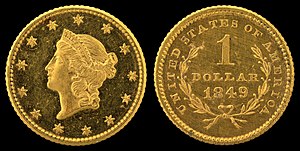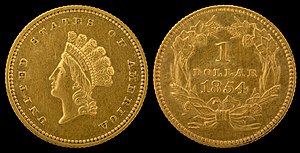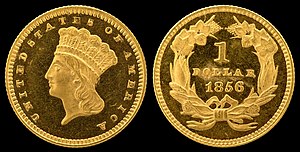|
The gold dollar is a gold coin that was struck as a regular issue by the United States Bureau of the Mint from 1849 to 1889. It had three types over its lifetime, all designed by Mint Chief Engraver James B. Longacre. The Type 1 issue had the smallest diameter of any United States coin ever minted. A gold dollar had been proposed several times in the 1830s and 1840s, but was not initially adopted. Congress was finally galvanized into action by the increased supply of bullion from the California gold rush, and in 1849 authorized a gold dollar. In its early years, silver coins were being hoarded or exported, and the gold dollar found a ready place in commerce. Silver again circulated after Congress required in 1853 that new coins of that metal be made lighter, and the gold dollar became a rarity in commerce even before federal coins vanished from circulation amid the economic disruption of the American Civil War. Gold did not circulate again in most of the nation until 1879, and even then, the gold dollar did not regain its place in commerce. In its final years, struck in small numbers, it was hoarded by speculators and mounted in jewelry. Coin design credit: United States Mint See alsoedit |


